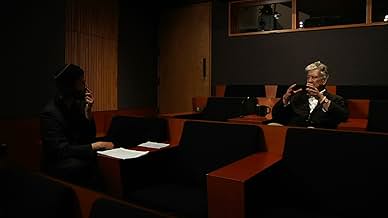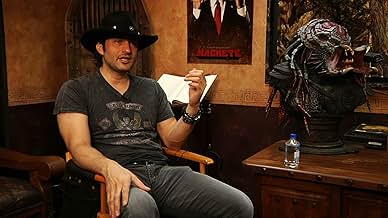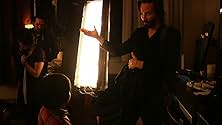NOTE IMDb
7,6/10
14 k
MA NOTE
Ajouter une intrigue dans votre langueThe documentary investigates the history, process and workflow of both digital and photochemical film creation.The documentary investigates the history, process and workflow of both digital and photochemical film creation.The documentary investigates the history, process and workflow of both digital and photochemical film creation.
- Réalisation
- Scénario
- Casting principal
- Récompenses
- 1 nomination au total
Avis à la une
I tend to read proper film critics for their opinions not only on specific films but also essays on themes, genres, movements and so on; I consider myself a total amateur on such subjects but I find it interested to listen to those who are not. Coming to Side by Side I wasn't sure if it would be too dry for me to get into or if it would be too simplistic for me to stay interested in for just under two hours. The film essentially looks at the transition from celluloid to digital in film making – from filming through to post through to projection in the cinema and the means of delivery to the viewer. It is an ambitious goal but it is one that it does very well and in a way that flows and is accessible.
I guess that for those with a real good working knowledge of the technology and the process, it may be too simplistic but for the casual viewer and enjoyer of films, there is enough detail here to engage and interest, but not so much that I felt overwhelmed with technical detail that I wasn't interested in. The film is really made up of Reeves acting as interviewer with a range of people involved in all the various aspects of the process – directors, cinematographers, editors, camera manufacturers etc. and he does a decent job, but not a great job in this regard. Fortunately this is not really his main role because it certainly seems that as producer he has helped Kenneally get a lot of very famous people to agree to be in the film. This range of talent and opinion makes for an interesting film, so while we follow development of things over time, we tend to get both sides as the title suggests.
Most of the contributors are interesting and their soundbites are well edited and the film itself is put together very well so that it covers time and technology in a way that makes sense, engages and never outstays its welcome. It probably won't do much for the technical enthusiast but for fans of film and cinema it is very much worth seeing as entertainment and education.
I guess that for those with a real good working knowledge of the technology and the process, it may be too simplistic but for the casual viewer and enjoyer of films, there is enough detail here to engage and interest, but not so much that I felt overwhelmed with technical detail that I wasn't interested in. The film is really made up of Reeves acting as interviewer with a range of people involved in all the various aspects of the process – directors, cinematographers, editors, camera manufacturers etc. and he does a decent job, but not a great job in this regard. Fortunately this is not really his main role because it certainly seems that as producer he has helped Kenneally get a lot of very famous people to agree to be in the film. This range of talent and opinion makes for an interesting film, so while we follow development of things over time, we tend to get both sides as the title suggests.
Most of the contributors are interesting and their soundbites are well edited and the film itself is put together very well so that it covers time and technology in a way that makes sense, engages and never outstays its welcome. It probably won't do much for the technical enthusiast but for fans of film and cinema it is very much worth seeing as entertainment and education.
As a film student or just a movie lovers, you rarely got a chance to connect with cinema history, or meet with famous people in the industry who set the standard and created the masterpieces. This documentary gives it all in a friendly story telling mode that could benefit both professionals or just any random viewers
As much as it is about digital, it's equally about how cinema develop and what it would be like in the future. The documentary points out an interesting finding that it's the professionals, not the technology that drives the storytelling art forward. Each and every of them offer their best performance and artistry via the choice of techniques they made.
It's fantastic to see how filmmakers form different groups of opinions and stay faithful to it. While the film did not intend to come to any conclusion about future of cinema in digital or old style film, it clearly set up a basic understanding about filmmaking as a painstakingly process that require endless decision making based on personal visual creative interpretation.
A nice to watch movie for film students, especially those are fans of David Lynch, James Cameroon or George Lucas, the main speakers
As much as it is about digital, it's equally about how cinema develop and what it would be like in the future. The documentary points out an interesting finding that it's the professionals, not the technology that drives the storytelling art forward. Each and every of them offer their best performance and artistry via the choice of techniques they made.
It's fantastic to see how filmmakers form different groups of opinions and stay faithful to it. While the film did not intend to come to any conclusion about future of cinema in digital or old style film, it clearly set up a basic understanding about filmmaking as a painstakingly process that require endless decision making based on personal visual creative interpretation.
A nice to watch movie for film students, especially those are fans of David Lynch, James Cameroon or George Lucas, the main speakers
"People love great stories. They love to get into a world and have an experience. And how they get it—it doesn't really matter." David Lynch
Which do you prefer: photochemical or digital projection for your movies? If you're geeky enough, you really care; if not, like me, you want a great story and characters with a crisp image that complements the theme, regardless of whether or not it's film. As for 3D, I can live without it.
Christopher Kenneally's interesting Side by Side documentary presents filmmakers like George Lucas who claim celluloid is dead and those like Christophe Nolan who vow not yet to trade his "oil paints for crayons." The film does a credible job presenting both sides with a slight edge to a future of all digital and a pessimistic take on film as an eventual curiosity.
Among the talking heads are avatars of photography and direction with an occasional producer and actress to get closer to us viewers, who are never questioned even though we are the ultimate arbiters. But the experts have valid and provocative points: the film advocates tout its warmth and color possibilities while the digital dudes trumpet the ease, low cost, and creative infinity. The film does an entertaining job of presenting the sides.
Both sides agree archiving remains a pressing and often neglected issue. Although Martin Scorsese is at the forefront of saving film, no one else has yet taken the case of digital preservation with his passion. The documentary doesn't take enough time on this issue especially since I thought something like my external hard drive would already be in the mix. Not. Apparently even digital imaging can break down in storage.
Oh, well, I'm with Lynch: Give me a super story and beautiful image and let the geeks and gods work out the details.
Which do you prefer: photochemical or digital projection for your movies? If you're geeky enough, you really care; if not, like me, you want a great story and characters with a crisp image that complements the theme, regardless of whether or not it's film. As for 3D, I can live without it.
Christopher Kenneally's interesting Side by Side documentary presents filmmakers like George Lucas who claim celluloid is dead and those like Christophe Nolan who vow not yet to trade his "oil paints for crayons." The film does a credible job presenting both sides with a slight edge to a future of all digital and a pessimistic take on film as an eventual curiosity.
Among the talking heads are avatars of photography and direction with an occasional producer and actress to get closer to us viewers, who are never questioned even though we are the ultimate arbiters. But the experts have valid and provocative points: the film advocates tout its warmth and color possibilities while the digital dudes trumpet the ease, low cost, and creative infinity. The film does an entertaining job of presenting the sides.
Both sides agree archiving remains a pressing and often neglected issue. Although Martin Scorsese is at the forefront of saving film, no one else has yet taken the case of digital preservation with his passion. The documentary doesn't take enough time on this issue especially since I thought something like my external hard drive would already be in the mix. Not. Apparently even digital imaging can break down in storage.
Oh, well, I'm with Lynch: Give me a super story and beautiful image and let the geeks and gods work out the details.
An immensely intriguing tour of the evolution of filmmaking process in the cinematic medium over the years, Side by Side is a side by side comparison of the two formats of crafting a motion picture that's available to filmmakers today; first is shooting on photochemical film which has been in use since the dawn of cinema while the other is shooting digitally which dominates the industry at present & has made the traditional film stock an endangered format.
Directed by Christopher Kenneally, this documentary presents Keanu Reeves as the questioner discussing about the evolution, impact & innovations the film camera has made since its creation and joining him in the discussion are Hollywood's esteemed directors like Martin Scorsese, James Cameron, Richard Linklater, David Fincher, Christopher Nolan & many more plus it also asks the opinions of various cinematographers, editors, VFX supervisors & others as well.
Side by Side provides a thorough examination of the history of 35mm print while also capturing the dawn, rise & revolution of digital format in the past two decades which as of today threatens the very existence of traditional filmmaking format. We get to see strong proponents for both formats, each presenting very valid arguments when it comes to the benefits & limitations of both film stock & digital recording in things like ease of use, economy, flexibility etc.
On an overall scale, Side by Side beautifully covers the still ongoing battle of the superior format in the film industry today and my only gripe with it is that it's only 98 minutes long. Even though in my opinion digital cinema seems to be a valid choice in the long run, IMAX has given film stocks a fresh breathe of life, and if only both formats can mutually co-exist then it's a win-win situation for the industry. Extremely gripping, highly entertaining & downright informative, Side by Side is a must-watch for every cinema fan out there.
Directed by Christopher Kenneally, this documentary presents Keanu Reeves as the questioner discussing about the evolution, impact & innovations the film camera has made since its creation and joining him in the discussion are Hollywood's esteemed directors like Martin Scorsese, James Cameron, Richard Linklater, David Fincher, Christopher Nolan & many more plus it also asks the opinions of various cinematographers, editors, VFX supervisors & others as well.
Side by Side provides a thorough examination of the history of 35mm print while also capturing the dawn, rise & revolution of digital format in the past two decades which as of today threatens the very existence of traditional filmmaking format. We get to see strong proponents for both formats, each presenting very valid arguments when it comes to the benefits & limitations of both film stock & digital recording in things like ease of use, economy, flexibility etc.
On an overall scale, Side by Side beautifully covers the still ongoing battle of the superior format in the film industry today and my only gripe with it is that it's only 98 minutes long. Even though in my opinion digital cinema seems to be a valid choice in the long run, IMAX has given film stocks a fresh breathe of life, and if only both formats can mutually co-exist then it's a win-win situation for the industry. Extremely gripping, highly entertaining & downright informative, Side by Side is a must-watch for every cinema fan out there.
10taifunu
this film is. It's about marking a turning point in the history of cinema and raising awareness about it. Yes, it's a subject that's been discussed and bitched about for what, 10 years now, ever since Lucas proclaimed that film is dead. But maybe for the first time it brings all the opposite opinions together. Side by side. (Loved the editing - it was just like watching a tennis match) And for people like myself, 'civilian' moviegoers who while watching a movie often found themselves forgetting about the popcorn and instead wondering 'how it's made?', this film is like Christmas in June :) I mean, I've read a bit about film making; I've come across some of the terms and looked up their definition; I knew what a DP does; I've scratched a bit the surface of the whole wide world of movie making. But to have the main processes explained clearly, precisely and in a language I could understand, all this in a one-and-a-half hour film, was like... like attending film school but without the (almost always compulsory) elitism and snobbery ;) :D
And watching the documentary at a film festival was a special experience per se. It was shown in a small old-fashioned theater, with creaking seats and wood floors and velvet curtains and no air conditioning; and old theater where once I used to go watch old cinematheque movies in black-and-white. There was a bitter-sweet irony about it. The audience was formed mainly by film festival guests and film students; people with technical background in movie making, and a few lost souls like myself, who just wanted to watch the documentary we read so much about. And it was a joy to see them react to the technical jokes; to hear a few of them hoot when on the screen someone was talking about the operator and the DP losing their god-like status on the set, or to hear them snicker when Cameron rhetorically asks Reeves 'you've been on a few sets in your life, haven't you?'
It's a film about nostalgia and inevitability, with a very light note of sadness.
But this was just the first date, and I'm quite taken with the film, so I'd really like to get to know it better. You know, take it on a second date, then a third. I'll take it to the movies, the old-fashioned way ;) I'll wine it, dine it, maybe even take it on the obligatory weekend to Paris. It could be the beginning of a long lasting relationship. So, when is the DVD gonna be released ? ;) :)
And watching the documentary at a film festival was a special experience per se. It was shown in a small old-fashioned theater, with creaking seats and wood floors and velvet curtains and no air conditioning; and old theater where once I used to go watch old cinematheque movies in black-and-white. There was a bitter-sweet irony about it. The audience was formed mainly by film festival guests and film students; people with technical background in movie making, and a few lost souls like myself, who just wanted to watch the documentary we read so much about. And it was a joy to see them react to the technical jokes; to hear a few of them hoot when on the screen someone was talking about the operator and the DP losing their god-like status on the set, or to hear them snicker when Cameron rhetorically asks Reeves 'you've been on a few sets in your life, haven't you?'
It's a film about nostalgia and inevitability, with a very light note of sadness.
But this was just the first date, and I'm quite taken with the film, so I'd really like to get to know it better. You know, take it on a second date, then a third. I'll take it to the movies, the old-fashioned way ;) I'll wine it, dine it, maybe even take it on the obligatory weekend to Paris. It could be the beginning of a long lasting relationship. So, when is the DVD gonna be released ? ;) :)
Le saviez-vous
- GaffesIdentifies District 9 (2009) as being shot on the Sony F23. It was actually shot on Red One cameras.
- Citations
Martin Scorsese: The only way you can make sure that a film or anything on the moving image is going to be around sixty or seventy years from now, interestingly enough, ironically enough, is celluloid.
- ConnexionsFeatured in Film '72: Épisode datant du 13 février 2013 (2013)
Meilleurs choix
Connectez-vous pour évaluer et suivre la liste de favoris afin de recevoir des recommandations personnalisées
- How long is Side by Side?Alimenté par Alexa
Détails
Box-office
- Montant brut aux États-Unis et au Canada
- 58 825 $US
- Week-end de sortie aux États-Unis et au Canada
- 6 956 $US
- 19 août 2012
- Montant brut mondial
- 67 054 $US
- Durée1 heure 39 minutes
- Couleur
- Rapport de forme
- 1.85 : 1
Contribuer à cette page
Suggérer une modification ou ajouter du contenu manquant

Lacune principale
By what name was Side by Side (2012) officially released in Canada in English?
Répondre




































